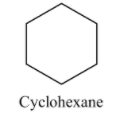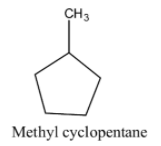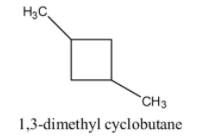
Cyclohexane, methylcyclopentane, 1, 3-dimethyl cyclobutane and 1, 2, 3- trimethyl cyclopropane are examples of which one of the following?
A. Constitutional isomers
B. Positional isomers
C. Structural isomers
D. Structural as well as positional isomers
Answer
225.3k+ views
Hint: We know that isomers are different in physical and chemical properties but have the same number of atoms. This phenomenon is termed as isomerism.
Complete step by step answer:
Structural isomers are those isomers where atoms are fully arranged with the same molecular formulae in different order. Molecular formula of Cyclohexane, methylcyclopentane, 1, 3-dimethyl cyclobutane and 1, 2, 3- trimethyl cyclopropane is ${{\rm{C}}_{\rm{6}}}{{\rm{H}}_{{\rm{12}}}}$.
Cyclohexane has 6 carbon and 12 hydrogen atoms. Now we draw structure of cyclohexane is as follows:

Methylcyclopentane has 6 carbon and 12 hydrogen atoms. Now we draw structure of methylcyclopentane is as follows:

1, 3-dimethyl cyclobutane has 6 carbon and 12 hydrogen atoms. Now we draw structure of 1, 3-dimethyl cyclobutane is as follows:

1, 2, 3- trimethyl cyclopropane has 6 carbon and 12 hydrogen atoms. Now we draw structure of 1, 2, 3- trimethyl cyclopropane is as follows:

Structural isomers are also termed as constitutional isomers. Constitutional isomers have the same molecular formula but numbering and IUPAC names are different. Only count the number of each atom in both molecules to see how atoms are organized to decide whether two molecules are constitutional isomers.
Position isomers are also structural or constitutional isomers with the same functional group and same carbon skeleton but differing in position of the same functional group on or inside the carbon chain.
Cyclohexane, methylcyclopentane, 1, 3-dimethyl cyclobutane and 1, 2, 3- trimethyl cyclopropane are structural isomers because they have same molecular formula $\left( {{{\rm{C}}_{\rm{6}}}{{\rm{H}}_{{\rm{12}}}}} \right)$ but different bonding arrangement.
Hence, the correct answer is C.
Note:
Isomers are classified as structural (constitutional) and stereoisomerism. Structural isomers are further classified as chain isomers, position isomers and functional group isomers.
Complete step by step answer:
Structural isomers are those isomers where atoms are fully arranged with the same molecular formulae in different order. Molecular formula of Cyclohexane, methylcyclopentane, 1, 3-dimethyl cyclobutane and 1, 2, 3- trimethyl cyclopropane is ${{\rm{C}}_{\rm{6}}}{{\rm{H}}_{{\rm{12}}}}$.
Cyclohexane has 6 carbon and 12 hydrogen atoms. Now we draw structure of cyclohexane is as follows:

Methylcyclopentane has 6 carbon and 12 hydrogen atoms. Now we draw structure of methylcyclopentane is as follows:

1, 3-dimethyl cyclobutane has 6 carbon and 12 hydrogen atoms. Now we draw structure of 1, 3-dimethyl cyclobutane is as follows:

1, 2, 3- trimethyl cyclopropane has 6 carbon and 12 hydrogen atoms. Now we draw structure of 1, 2, 3- trimethyl cyclopropane is as follows:

Structural isomers are also termed as constitutional isomers. Constitutional isomers have the same molecular formula but numbering and IUPAC names are different. Only count the number of each atom in both molecules to see how atoms are organized to decide whether two molecules are constitutional isomers.
Position isomers are also structural or constitutional isomers with the same functional group and same carbon skeleton but differing in position of the same functional group on or inside the carbon chain.
Cyclohexane, methylcyclopentane, 1, 3-dimethyl cyclobutane and 1, 2, 3- trimethyl cyclopropane are structural isomers because they have same molecular formula $\left( {{{\rm{C}}_{\rm{6}}}{{\rm{H}}_{{\rm{12}}}}} \right)$ but different bonding arrangement.
Hence, the correct answer is C.
Note:
Isomers are classified as structural (constitutional) and stereoisomerism. Structural isomers are further classified as chain isomers, position isomers and functional group isomers.
Recently Updated Pages
JEE Main 2025-26 Mock Test: Organic Compounds Containing Nitrogen

JEE Main 2025-26 Organic Compounds Containing Nitrogen Mock Test

JEE Main Chemical Kinetics Mock Test 2025-26: Free Practice Online

JEE Main 2025-26 Organic Compounds Containing Oxygen Mock Test

JEE Main 2025-26 Organic Compounds Containing Halogens Mock Test

Sodium acetate on heating with soda lime produce A class 12 chemistry JEE_Main

Trending doubts
JEE Main 2026: City Intimation Slip and Exam Dates Released, Application Form Closed, Syllabus & Eligibility

JEE Main 2026 Application Login: Direct Link, Registration, Form Fill, and Steps

Understanding the Angle of Deviation in a Prism

Hybridisation in Chemistry – Concept, Types & Applications

How to Convert a Galvanometer into an Ammeter or Voltmeter

Ideal and Non-Ideal Solutions Explained for Class 12 Chemistry

Other Pages
NCERT Solutions For Class 12 Chemistry Chapter 1 Solutions - 2025-26

JEE Advanced Marks vs Ranks 2025: Understanding Category-wise Qualifying Marks and Previous Year Cut-offs

Solutions Class 12 Chemistry Chapter 1 CBSE Notes - 2025-26

NCERT Solutions ForClass 12 Chemistry Chapter Chapter 4 The D and F Block Elements

Biomolecules Class 12 Chemistry Chapter 10 CBSE Notes - 2025-26

NCERT Solutions For Class 12 Chemistry Chapter 10 Biomolecules - 2025-26




